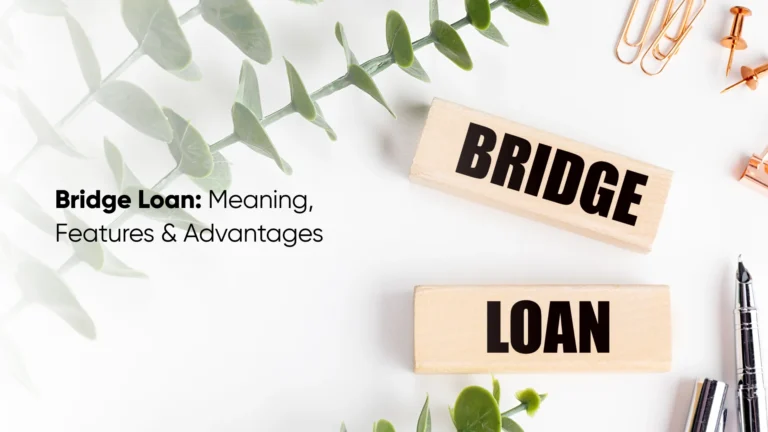Table of Contents
ToggleWhat is a Bridge Loan?
A bridge loan is a short-term loan that is offered to bridge financial gaps when you are short on funds. The main feature of a bridge loan is quick access to funds in urgent financial situations. They are typically designed for a short term that can range from 12 to 24 months, to be repaid over a short duration.
For instance, a family in Chennai may need urgent money to cover medical bills while they wait for their insurance to be processed. A bridge loan will offer quick financial relief and bridge that funding gap.
Bridge loans are short-term loans with a high interest rate due to the urgent nature of the funding requirement. Loan disbursal is quick to offer funds on time. They typically require collateral to mitigate the risk.
Key Features of Bridge Loans
Bridge loans are designed to offer quick funds to individuals and businesses in times of urgent financial need. If you are considering getting a bridge loan, it is important to understand its key features.
- Short Tenure: As they are designed to offer funds for temporary financial pinch, they usually have a loan tenure between 12 – 24 months. This ensures borrowers use it to cover urgent financial gaps rather than using it as a permanent fund (for property sale)
- Collateral-Backed Financing: Bridge loans are often secured loans. Lenders may require you to pledge an asset like property or business to reduce their risk.
- Higher Interest Rates: Bridge loans have a high interest rate as they involve a higher risk for lenders. In India, bridge loans carry 8% to 18% per annum
- Fast Processing and Disbursal: The main advantage of a bridge loan is the speed. Loan approval and disbursal are quick, giving you access to funds during urgent or time-sensitive needs.
- Flexible Repayment Options: Many lenders offer flexible repayment structures, as per the borrower’s convenience, to help ease the financial burden. Repayment structure could range from interest-only payments to lump sum repayments.
- Higher Loan Amount: A bridge loan typically requires collateral, and thus, the borrower can get a higher loan amount against it. This is especially helpful in property transactions when you need a large amount for a down payment or a business needs to pay vendor fees.
How Does a Bridge Loan Work?
A bridge loan is designed to cover short-term financial needs. Suppose Priya wants to shift from her 1BHK to a new 2BHK apartment. The new property requires a down payment; however, the paperwork for selling her old flat is still in process. In such a case, she can take a bridge loan to cover this gap. Once her old flat sells, she can utilise those funds towards the new apartment.
Here is how a bridge loan works:
- Application Process
You apply for a bridge loan at the bank. Understand the lender’s terms and collateral requirements, if any.
- Common Documents
Most lenders require documents for KYC (Aadhar or PAN card), property documents, and income proof.
- Loan Disbursal
Upon approval, the loan is disbursed typically within 3 – 7 working days.
- Loan Repayment
Once the fund gap is fulfilled, the repayment can be done in several ways. This includes a lump sum payment, EMI-based, or a bullet payment.
Before you take a bridge loan, understand the entire process and assess if this is the right option for you. A sound repayment plan is advisable for a stress-free borrowing process.
Bridge Loan Documents Required
When applying for a bridge loan, ensure that you have all your documents in place, as required by the lender. If you submit the right documents and fulfill eligibility, you significantly improve your chances of approval. Most lenders typically require these documents for a bridge loan:
- Identity Proof: PAN card, Aadhaar card, or voter ID to verify your personal identity.
- Address Proof: Utility bills, Aadhaar, or a rent agreement to verify your residential address.
- Income Proof: Salary slips, Form 16, ITR or GST returns (businesses), or bank statements (for self-employed applicants).
- Property Documents: Sale agreement, Title deed (for existing property), NOC from society, if the loan is secured against real estate.
- Bank Statements: Last 6–12 months’ statements to check financial status and repayment ability.
- Employment or Business Proof: Appointment letter or employee ID for salaried; business registration or trade license for self-employed borrowers.
- Credit Report: A recent CIBIL score or credit history statement to evaluate repayment track record.
Advantages of Bridge Loan
A bridge loan is typically taken when you have a short-term financial need and require funds until your permanent solution is resolved. It is typically taken by individuals when they are either selling their old property or putting down a deposit for a new one. Even a business may require short-term funds. Say they need to pay their vendor in advance, and the client’s payments would be received later. In such a case, a bridge loan is a smart option to consider.
If you are considering a bridge loan, here are the advantages of it:
- Quick Access to Funds: A key advantage of a bridge loan is quick funds during critical times. When timely payments are critical, like property deposit or business liquidity, this speed helps to get funds faster.
- Flexibility in Repayment: Bridge loans have a flexible repayment structure. You can comfortably repay the loan once you receive funds, say from a client or a sale of property.
- High Loan Amount: As these loans are typically secure (requiring collateral), you can apply for a high loan amount. A good option to consider when you require large funds in a short span of time.
- Minimal Paperwork: The paperwork is minimal, saving time and effort required to secure the loan.
Risks of Bridge Loans
While bridge loans have several advantages, it is equally important to weigh the potential risks involved in taking one. Here are a few likely risks that you must consider before taking the loan:
High Interest Rates: Bridge loans have high interest rates, as the funds are typically large and disbursed quickly. Thus, you may need to pay a considerable amount on the EMI amount.
Shorter Tenure: Bridge loan must typically be repaid in 6 – 12 months. This can potentially put a financial strain on the borrower if they fail to secure large funds. Say your house sale gets delayed or cash flow gets stuck due to a payment delay (in businesses).
Potential Collateral: As a borrower, when you take a bridge loan, you pledge an asset or property against the loan. If there are delays or missed repayments, you potentially risk losing your assets, adding further financial strain.
Bridging Loan Repayments: What to Know?
Loan repayments are quite flexible for bridge loans. Lenders allow borrowers to choose a repayment structure that best fits them, based on the expected cash flow. Many lenders offer lump sum or EMI repayment, while some offer interest-only payments.
Common Bridge Loan Payment Option
Repayment Type | Description | Best Suited For |
Interest-Only Payments | Pay only the interest amount, and repay the principal at the end of the loan term. | Borrowers awaiting property sale proceeds. |
Lump-Sum Repayment | Pay the full loan amount (principal & interest) at once, when funds are available. | Short-term borrowers with assured cash inflows. |
Monthly EMIs | Fixed monthly payments that include both principal and interest. | Borrowers with consistent income sources. |
Refinancing Option | Convert the bridge loan into a long-term loan to extend tenure and reduce EMIs. | If the borrower faces delays in receiving payments. |
Prepayment Facility | Option to close the loan early; some lenders may levy a minor penalty. | Borrowers who want to reduce total interest costs. |
Bridge Loan vs Personal Loan: Key Differences
If you have any short-term financial requirements, a bridge loan and a personal loan are good loan options to consider. While they may seem similar, they are used for different purposes. Let’s understand the difference between a bridge loan and a personal loan:
Criteria | Bridge Loan | Personal Loan |
Purpose | It is used to cover temporary funding gaps. For instance, when you sell an existing property and purchase a new one. | It is typically used to cover personal expenses like home renovation, medical bills, travel, or debt consolidation. |
Tenure | Short-term, usually 6–12 months. | Medium-term, typically between 1–5 years. |
Collateral Requirement | Secured. One needs to pledge their property or other assets. | Unsecured. No collateral required. |
Interest Rate | Generally higher, as it is a high-risk and short-term loan. | Lower compared to bridge loans. Also, it depends on credit score and lender. |
Loan Amount | One can get a high loan amount depending on the asset pledged. | Moderate, depends on income, credit score, and repayment capacity. |
Processing Time | Fast approval for property-related transactions. | Quick and fully digital through personal loan apps like Zype. |
Repayment Method | Mostly in a lump sum or short EMIs after property sale. | Fixed monthly EMIs over the loan tenure. |
When to Consider a Bridge Loan?
If you have a short-term financial gap, you can consider a bridge loan. It is a quick solution to get funds and maintain cash flow during a crucial time, while you wait for your funds to arrive.
Common reasons to opt for a bridge loan:
- New Property Purchase While Awaiting Sale of Existing Property: If you’ve purchased a new property but your existing house is yet to sell, a bridge loan will get you the funds needed for the down payment. Once your current property is sold, you can repay the loan in full. This is one of the most common reasons for getting a bridge loan.
- Cash Flow Gaps: Businesses often face temporary working capital shortages when a project payment is pending or a large receivable is pending. A bridge loan fills the gap to pay the suppliers, manage payroll, or keep operations running smoothly until revenue arrives.
- Urgent Payments: When you’re awaiting funds from another source like an approved loan, property deal, or investment, a bridge loan can help you cover short-term expenses or dues, without delaying financial commitments.
Thus, a bridge loan is typically used for instant liquidity, where the borrower is confident of getting permanent funds. They just need funds to bridge that gap, as the payment could be time sensitive, like a down payment on a house or a business having to pay its vendors.
Frequently Asked Questions (FAQs)
What Is The Typical Interest Rate For Bridge Loans In India?
The typical interest rate for a bridge loan in India ranges between 8% to 18% per year.
Can MRIs Apply For Bridge Loans In India?
Yes, NRIs can apply for a bridge loan in India. Many lenders offer bridge loans when one buys a property while the existing one sells.
How Long Does It Take To Get A Bridge Loan Approved?
For a bridge loan to get approved, it can take anywhere from a few days to a few weeks.
What Happens If I Cannot Repay My Bridge Loan On Time?
If you cannot repay your bridge loan on time, you face late fees and penalties. And in extreme cases, they may face legal action from the lender.
Are Bridge Loans Flexible In Terms Of Repayment?
Yes, bridge loans can be flexible in terms of repayment. It depends on the lender’s terms and repayment structure. Lenders offer a range of repayment options, including bullet, lump-sum, or EMI-based structures.
Can A Bridge Loan Be Used For Purposes Other Than Real Estate?
Yes, a bridge loan can be used for purposes other than real estate. It is a short-term loan that is typically used to cover funds for the short term and helps with fund gaps for individuals and businesses alike.
Is Collateral Mandatory For All Bridge Loans?
Collateral is not mandatory, but most lenders do require collateral as bridge loans are short-term, high-risk. Lenders ask for collateral to mitigate their risk.
Are There Any Tax Benefits Related To Bridge Loans?
For bridge loans, the tax benefits only apply when the funds are used either to finance real estate or a business purpose.









